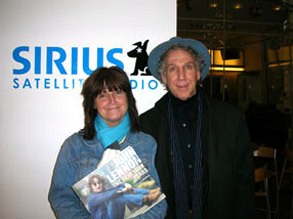Greetings from radio K-SAT! I’m still waiting for a single hour in the 2-day forecast that doesn’t include a chance of rain, but in the meantime the tomato plants look awesome! (Speaking of tomatoes (and potatoes), does anyone else yearn for those bygone days when Dan Quayle was the most polarizing figure in US politics?)
As some of you know, Stealing All Transmissions tidies up a limited number of loose ends, and I figure it’s about time I apprise you of the whereabouts of a handful of the protagonists, aides, and abettors. Meg Griffin, of course, is still spinning discs for Sirius-XM Radio, and is also one of the key subjects of a new documentary, I Am What I Play. (Roger King is one of the masterminds of this project, and he’s a good guy, so do check this out when it arrives in your city.) Here she is with rock photographer extraordinaire (and insanely sweet guy) Bob Gruen, who still keeps busy on the other side of the camera. They’re pictured, of course, with Mr. G.’s book on John Lennon.
Joe Piasek, Meg’s partner-in-crime at WPIX, followed up their “Elvis-to-Elvis” experiment to work at Nickelodeon, where the management better understood the ethos he fomented at WPIX. As of August 2010, Piasek is behind the scenes (and occasionally on the air) at radio station WIOX-FM, out of Roxbury, New York. The station is this odd public-private partnership that broadcasts 24/7, with roughly 19 hours a day of live programming made possible by more than 80 volunteers. The facility is a former Masonic Lodge with plenty of space for in-studio performances, dances–the works. I had the chance to visit Joe there in 2012, and he’s still as properly restless as he was circa 1980 when it comes to business-as-usual. If you’re looking for a good cause to support, tune into WIOX, and consider joining their underwriting forces. (I’m presently tuned into Lizzie Douglas, who’s just schooled listeners that the inspiration for The Beatles’ “Good Morning, Good Morning” was a Corn Flakes commercial in the UK–just the thing that US historians might miss.) The transmission is analog and digital, and you can download the WIOX App for free at the iTunes Store. Given the struggles of radio in general, watch for this model to spread–all it takes is a few more mavericks who are willing and able.
Two more items of note: check out this lovely Clash fan site, which hosts over 3000 photos of the lads and descriptions in French.
Toronto, of course, played a big role in Clash history. As the tour bus readied in September 1979 to return to the US, Mick staged a sit-down strike until someone secured some marijuana. Luckily, some fan procured the necessary goods, and I’d like to offer my thanks to that person, as the legendary shows at the Palladium a few nights later might have otherwise never commenced. In case there’s interest: I am making a quick visit to Toronto on Thursday, 18 July, and while I wasn’t diligent enough to arrange a reading/signing that evening, I’d be delighted to meet folks for lunch and a chat about The Clash, the book, aging with punk and dignity, etc. If you’re interested (or know someone who’s interested), please e-mail me by 12 July, so we can make arrangements at a downtown eatery. Cheers!






